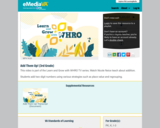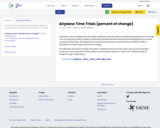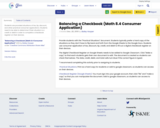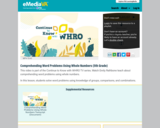
3rd Grade Multiplication Exit Ticket using Equal groups and Repeated Addition.
- Subject:
- Computation and Estimation
- Material Type:
- Activity/Lab
- Author:
- Ashley Harris
- Date Added:
- 07/25/2022

3rd Grade Multiplication Exit Ticket using Equal groups and Repeated Addition.

Students will analyze a provided math problem with an incorrect answer (bug). Students will demonstrate their understanding of the process by identifying the error, solving the problem correctly and providing an explanation. Math problem solving directly correlates with the step by step process that computer science debugging requires. The purpose of this experience is to provide a jumping off point for a deeper understanding of the Computer Science SOLs. This could be the first time your students are exposed to the vocabulary (algorithm, bug, debugging) and can provide a good foundation of the understanding of the vocabulary in a concrete, low-technology way.

This performance task has the students working as bookkeepers for a P.P.E. Manufacturing Company to see how many P.P.E. they sold by adult and children sizes over a 2-3 month period of time and if their price of production vs cost for consumers to buy was enough that they made a profit or if they needed to make adjustments. This performance task has the students using PEMDAS to better understand how Algorithms and Programming are used in our everyday lives.

In this performance task, students will have the opportunity to demonstrate the use of flowcharts in Google Draw and then create their own flowchart to show their understanding of the Order of Operations.

This video is part of the Learn and Grow with WHRO TV series. Watch Nicole Neice teach about addition.

Adding and subtracting fractions with like denominators - Mathematics Instructional Plans (MIPs) help teachers align instruction with the 2016 Mathematics Standards of Learning (SOL) by providing examples of how the knowledge, skills and processes found in the SOL and curriculum framework can be presented to students in the classroom.

Adding and subtracting whole numbers. Mathematics Instructional Plans (MIPs) help teachers align instruction with the 2016 Mathematics Standards of Learning (SOL) by providing examples of how the knowledge, skills and processes found in the SOL and curriculum framework can be presented to students in the classroom.

Estimating and finding sums and differences of whole numbers Mathematics Instructional Plans (MIPs) help teachers align instruction with the 2016 Mathematics Standards of Learning (SOL) by providing examples of how the knowledge, skills and processes found in the SOL and curriculum framework can be presented to students in the classroom.

This lesson uses an experiment with paper airplanes to provide data to practice finding percent of change.

Solving practical problems involving operations with integers Mathematics Instructional Plans (MIPs) help teachers align instruction with the 2016 Mathematics Standards of Learning (SOL) by providing examples of how the knowledge, skills and processes found in the SOL and curriculum framework can be presented to students in the classroom.

Students are provided situations of tax, tip, discount, and other practical consumer applications. Students need to be able to determine if their situation is a credit or debit in order to complete a checkbook register on their devices.

Recognizing and describing part-whole relationships for numbers up to 10Mathematics Instructional Plans (MIPs) help teachers align instruction with the 2016 Mathematics Standards of Learning (SOL) by providing examples of how the knowledge, skills and processes found in the SOL and curriculum framework can be presented to students in the classroom.

Students lean about proportions, ratios, and unit rate. It is important for connections to be made among ratio tables, graphing points, and slope of a line. Students make these connections through the first activity provided by the VDOE. The second task by Illustrative Mathematics is a way to assess student understanding.

In this lesson students will practice computing the average or mean of 3 or more menu prices or numbers with decimals.

Teacher Instructs the student to navigate to Google.com. The teacher will model researching their career by typing in the search box, “What is the average salary for a teacher in Virginia.” The teacher will ask what does average salary mean and add details to the students’ responses. The teacher will then pull up the Google Sheet to be used for today’s lesson. Students will begin researching their own career choice by typing, “What is the average salary of a _______________________ in VIrginia? The students will find a low, average, and top salary for their career choices. The students will use the average or middle salary given. If more than one average is given the students will use the mathematical equation for finding the mean to calculate the average of the salaries given.

Students will lead discussion on their net pay for their chosen career, their total expenses, and the amount they will have left after paying all the monthly expenses. If there wasn’t enough money to pay all their expenses what will they need to do?

Students will research the cost of homes and expences associated with owning a home. This proccess will help the studet to determine if thier chosen salary will support the purchase of the selected home.

Students will pretend they have a family of 4. Use the list given by students and make sure the following are included: average cost of groceries for a family of 4average cost of health insurance for a family of 4average cost of dining out for a family of 4 (multiply this by 4 for eating out once a week)average monthly internet feeaverage monthly cable or satellite

The teacher will lead discussion on cost of the vehicle versus the salary made for his/her career. What are the pros and cons of this vehicle? Students will then research the type of vehicle they want. Each student will determine the cost of the vehicle. Students will share with each other the type of vehicle they chose, the cost of the vehicle, and the pros and cons of the vehicle.

This video is part of the Continue to Know with WHRO TV series. Watch Emily Rathbone teach about comprehending word problems using whole numbers.